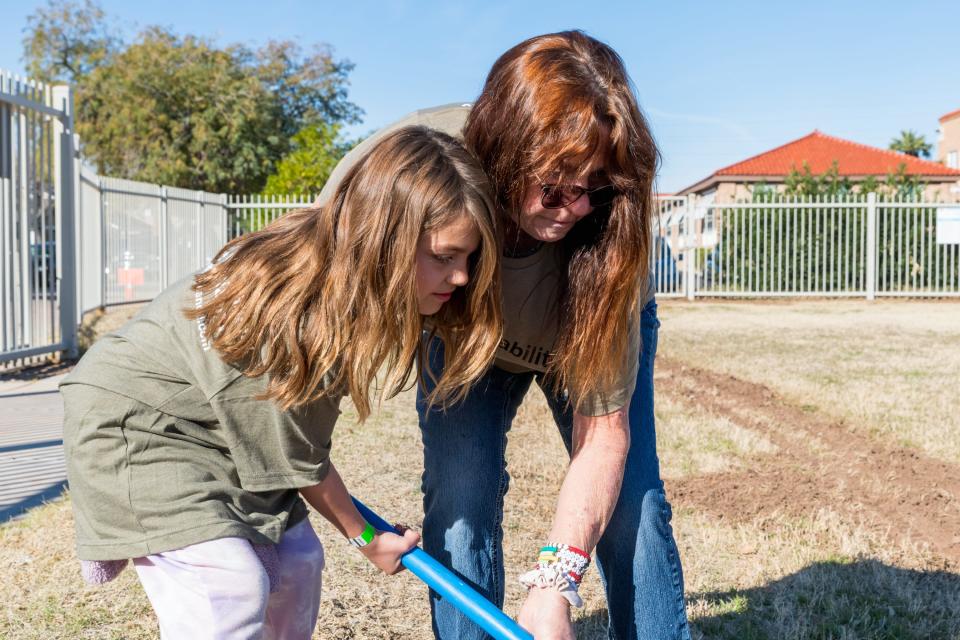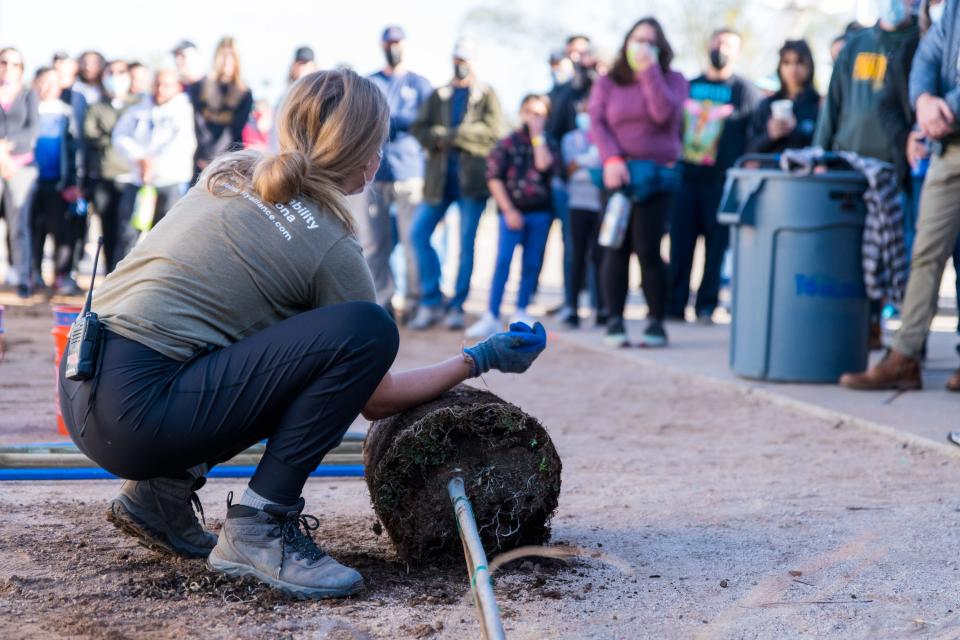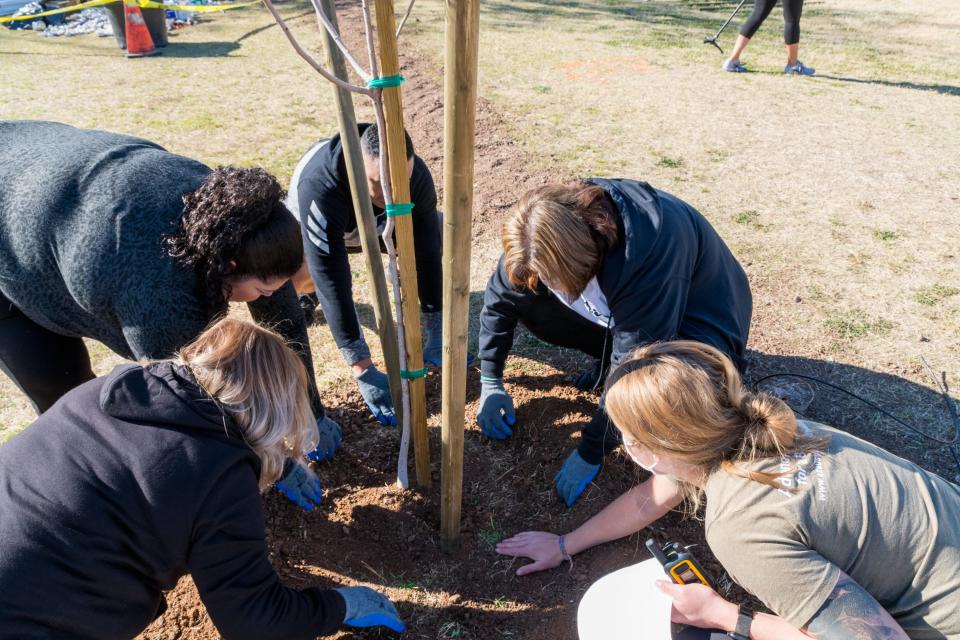Trees growing at Emerson Elementary will expand the shade canopy and build community
Nick Lodato wanted to do something big to celebrate the 100th anniversary of Emerson Elementary School, where he is the principal. As a lover of nature, he decided there could be no better way than to plant trees.
The anniversary event should emphasize the school’s strong community, he thought. Located in the historic Coronado neighborhood, Emerson is one of the oldest schools in the area. When the Phoenix Elementary District proposed to consolidate it with other K-8 schools a few years back, hundreds of people rallied in support of maintaining the school.
Planting trees, Lodato said, would serve the dual role of sustaining both the environment and the community. It was also an investment in the school’s future.
He worked with the Arizona Sustainability Alliance, a local conservation nonprofit, to sow more than 100 trees and plants across Emerson’s campus, at an event attended by about 125 people.
The tree-planting centennial featured a wide variety of volunteers: Emerson students and their parents, Tau Psi Omega fraternity members, APS employees and their families, neighbors, former Emerson students and teachers, and ASU history students.
The volunteers, many of them children, dug holes, placed trees and plants inside and then shoveled the dirt in, listening to members of the Arizona Sustainability Alliance as they explained how wind could affect the stability of trees, how to water the plants for maximum efficiency and other logistics.
“I came here today because I want to plant some trees,” said Zoe Avila, a fourth-grader who was the former president of the Tree Club. “I wanted to be very helpful to my school.”

Two wooden stakes hold up a tree whose bark is no wider than a thick Expo marker. In a decade or so, organizers hope these young saplings will shade future playground denizens as they play soccer, football or freeze tag in the open field.
Indian laurel ficus, a small tree that can be trimmed to resemble shrubs, will share teachers’ parked cars. Red push pistache — a tree with a large canopy cover, known for its red fall foliage — and fan west ash, which also produces a large canopy, will shade the school’s large open field where kids play during recess.
“If you were to go out and watch students, especially in the months of August, September and April, May, on the playground, they would be huddled around two or three sad-looking trees,” Lodato said. “Because it's the only shade that's out there, other than some big ramadas and shade structures. It’s the only natural shade.”
More than shade: Climate has changed Phoenix, but there's time to fix it
Shade and urban heat
Planting more trees is also a key component to heat mitigation, which has become increasingly important as experts predict Phoenix will become 3 to 5 degrees warmer on average in coming years. The city has taken the issue of urban heat so seriously in 2012 it established the country’s first publicly funded office of heat response and mitigation.
Climate change and the tendency of urban areas to concentrate and retain heat have both contributed to Phoenix’s urban heat problem. One of the heat mitigation office’s key goals is to increase Phoenix’s tree canopy cover, or the percentage of the city that’s shaded by trees. Right now, the city has a 13% canopy cover, but it’s hoping to increase that to 25% within a decade.
Trees “cool neighborhoods, which reduces heat-related illnesses and utility costs, and generate wealth by creating tree-related career opportunities," according to the nonprofit American Forests. "Much like buildings, streets and sewer lines, trees are critical infrastructure that improve our quality of life. But a map of tree cover in America’s cities is too often a map of income and race.”

Emerson, an economically diverse but majority Hispanic school, has only a 9% tree canopy cover, which is part of the reason why the Arizona Sustainability Alliance chose to fund the project, according to Kayla Killoren, a programs manager for the alliance who helped coordinate the tree planting at the school.
“We always like to prioritize areas that are high need and don't have a dense tree canopy, because we're trying to mitigate the urban heat island effect,” Killoren said.
While planting over 100 trees and plants is significant, it will only make a dent in Emerson’s tree canopy dearth, according to Killoren.
“No single effort really achieves the goal,” Lodato said. “It's when all these things combine that you start to improve air quality for breathing for people who are asthmatic, access to shade and access to cooler spaces, to make the outdoor living more enjoyable for more months of the year.”
Native, drought-tolerant species

Emerson planted 58 trees and 58 plants, prioritizing native species. Some were chosen for their shade, others for the aesthetics. All are drought-tolerant, which Lodato and Killoren said was important given the historic 22-year drought in Arizona, a dry period exacerbated by climate change.
But before the trees can live up to the name of being drought-tolerant, they need to be properly watered once every five days during their first year, Killoren said.
Some of the trees and plants chosen include Chilean mesquite, a cousin of a native species that doesn’t have thorns; desert willows, a native species with pink flowers that promote pollination; and desert senna, a native plant with yellow flowers common in Arizona.
The school estimated it would need $16,000 to plant the trees and plants and hold an event. It set the fundraising goal for $18,000, but it ended up raising more than $20,000 from eight different organizations and over 40 individuals.
Former teachers noted that Emerson once had plenty of trees. Christine Gillis, who taught at Emerson for 30 years, said the school planted trees in memory of the Challenger astronauts, who died in a space shuttle accident in 1986.
Some of the trees were damaged by storms during the monsoon and others died from natural causes, according to Linda Jeffries, a spokesperson for the school district.
Gillis also said some of the trees were cut down with the expansion of the school and playground, but the district was unable to confirm that.
“When they expanded the school and the playground, I don't think they really thought what it stood for and they were cut down,” Gillis said. “But I believe Nick when he says these trees will be here for our future.”
The Arizona Sustainability Alliance will return to Emerson in a few weeks to train teachers how to care for the trees.
Gillis added, “It scares me when I think of a possible future that these children might experience because of global warming and pollution... it just frightens me. They deserve so much more.”
Zayna Syed is an environmental reporter for The Arizona Republic/azcentral. Follow her reporting on Twitter at @zaynasyed_ and send tips or other information about stories to zayna.syed@arizonarepublic.com.
Environmental coverage on azcentral.com and in The Arizona Republic is supported by a grant from the Nina Mason Pulliam Charitable Trust. Follow The Republic environmental reporting team at environment.azcentral.com and @azcenvironment on Facebook, Twitter and Instagram.
Support local journalism: Subscribe to azcentral.com today.
This article originally appeared on Arizona Republic: Emerson Elementary plants trees to add shade, build community

